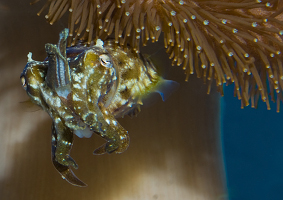 One of the most amazing aspects of the cuttlefish is their skin. The skin contains up to 200 pigment cells per square millimeter that enables it to change its camouflage at will.
One of the most amazing aspects of the cuttlefish is their skin. The skin contains up to 200 pigment cells per square millimeter that enables it to change its camouflage at will.
I have been working for the California Academy of Sciences for five years now this month. I have always held a fondness for the aquarium. On my first day of work, I took a tour with other new hires through the aquarium at Howard Street. We stopped at the giant sea bass’s tank. It was feeding time and we were given sardines to feed him. We were instructed by one of the biologists to hold the fish in two fingers just beneath the surface to let him suck the fish into his mouth. When it was my turn, I dutifully held the fish under the water and watched the huge fish round the tank and head my way. He approached quicker than I had anticipated and I got spooked. So I lifted the fish out of the water. Well he still sucked the fish up; but he also sprayed me with salt water and fish guts. So I started at the office, dripping in salt water and smelling of sardines.
Tonight after work, I descended down into the Steinhart Aquarium. It’s kind of an after-work tradition to tour the aquarium before heading home. I like to stop by and see the same giant sea bass that drenched me and the octopus next door when the lights have been dimmed and the halls are empty. I now often stop at the dwarf cuttlefish tank. Tonight, one of them was swimming around the top of the tank, shimmering in a varied and beautiful color display. The other dwarf cuttlefish was resting at the bottom of the tank, expertly matching the rocks around it.
One of the most amazing aspects of the cuttlefish is their skin. The skin contains up to 200 pigment cells per square millimeter that enables it to change its camouflage at will. It also has muscles in its skin that enable it to change its skin from smooth to rough. Different species of cuttlefish can change the color and texture of their skin to blend in with the environment around them, display spikes and bright colors to ward off predators, or even create a strobe color display to mesmerize prey.
As well, cuttlefish, part of the Cephalopoda family that includes squids and octopi, have one of the largest brain to body ratios of any invertebrate. They can take in input from sight, smell and sound in the form of pressure waves felt through their lateral lines. The reaction of color displays has demonstrated problem solving and biologists study them to learn more about invertebrate and possibly human intelligence.
